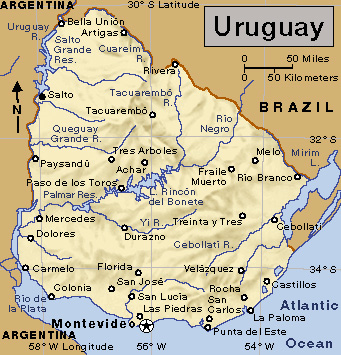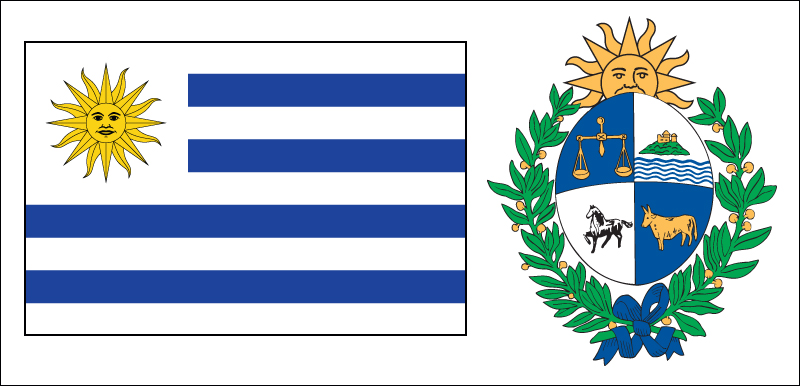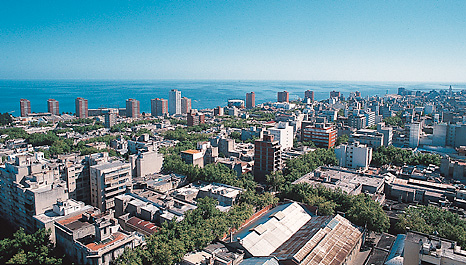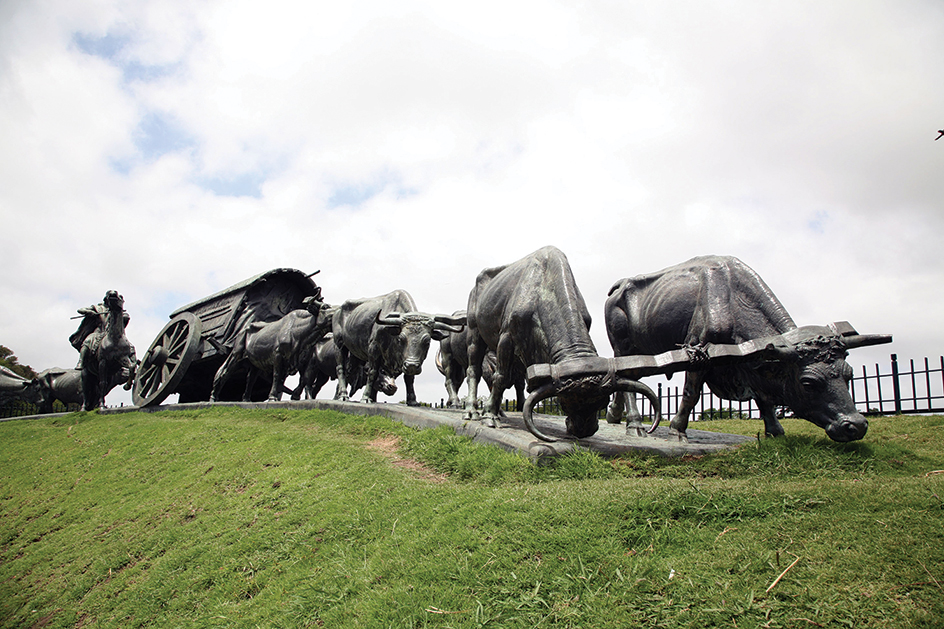Uruguay << YUR uh `gway` or `oo` roo GWY >> is a small country on the southeastern coast of South America. Among the independent nations of South America, only Suriname has a smaller area. Gently rolling grasslands cover almost all of the interior of Uruguay. Beautiful sandy beaches line the country’s Atlantic coast.

Most Uruguayans are descended from Spanish settlers who came to the country in the 1600’s and 1700’s and Italian immigrants who arrived during the 1800’s and early 1900’s. Spanish is the nation’s official language. Most Uruguayans live in urban areas, especially along the country’s southern coast. Montevideo is the capital and largest city. It has about half of the nation’s total population.
Service industries, such as government, tourism, and transportation, employ more people than any other part of Uruguay’s economy. But a mild climate and abundant natural pasture have made agriculture, particularly livestock raising, the base of the economy. Huge cattle and sheep ranches occupy most of the nation’s interior. The leading manufacturing industries of Uruguay process meat, wool, and other livestock products.
Indigenous (native) people were the original inhabitants of what is now Uruguay. However, almost all of them eventually were killed by European settlers or died of diseases brought by the Europeans. Spanish and Portuguese forces fought for control of Uruguay during the 1700’s, and Brazil later tried to dominate the country. Uruguay became an independent republic in 1828. During the early 1900’s, it developed into one of the most prosperous and democratic nations in South America. But an economic decline during the 1950’s and 1960’s brought about a period of widespread unrest and military rule. Today, an elected civilian government once again rules Uruguay. However, a lack of economic stability remains an ongoing concern.
Government
National government.
Since the early 1900’s, democratic governments have ruled Uruguay almost continuously. But in 1973, during a period of widespread urban violence, military leaders seized control of the government. They suspended the country’s Constitution, dissolved the national legislature, and banned all political party activities. The military ruled Uruguay until 1985. That year, a freely elected government once again assumed office.

Uruguay’s Constitution, adopted in 1967 and restored in 1985, provides for a republican form of government. Under the Constitution, voters elect a president, the country’s head, to a five-year term. The president may not be reelected until five years after leaving office. The president appoints a cabinet called the Council of Ministers to head various government divisions. Uruguay’s legislature is called the General Assembly. It consists of a Senate and a Chamber of Representatives. Voters elect legislators to five-year terms.
Local government.
Uruguay is divided into 19 departments for purposes of local government. Voters in each department elect a governor and a legislature to handle departmental affairs.
Politics.
The two largest political parties in Uruguay are the Colorado Party and the National Party, also known as the Blanco Party. The Colorados are traditionally more liberal and tend to be concerned with urban problems. The Blancos generally represent rural interests. Other political parties include the Christian Democratic Party, the Socialist Party, and the Communist Party. Segments of these parties sometimes combine in a larger group called the Broad Front coalition. All citizens 18 years of age and older are required to vote.
Courts.
The five-member Supreme Court of Justice serves as Uruguay’s highest court. The General Assembly elects the court’s justices to 10-year terms. The nation’s judicial system also includes appeals courts, various lower courts, and justices of the peace.
Armed forces.
Uruguay has an army, navy, and air force. Military service is voluntary.
People
Population and ancestry.
Most Uruguayans live along or near the southern coast. The interior is thinly populated.
Various Indigenous groups lived in what is now Uruguay long before the first Spanish settlers arrived in the 1500’s. However, by the late 1700’s, the Indigenous population had almost completely disappeared. During the 1800’s and early 1900’s, large numbers of Spanish and Italian migrant workers moved to Uruguay. Today, most Uruguayans are descended from these immigrants. Other groups with European ancestry include people of English, French, German, and Eastern European descent. About 5 percent of Uruguay’s people are mestizos (people with both European and Indigenous ancestry). Between 5 and 10 percent are Black people whose ancestors were brought to Uruguay and enslaved during the 1700’s and early 1800’s.
Language.
Nearly all Uruguayans speak Spanish, the country’s official language. They generally speak the language with an Italian accent. Many Uruguayans also speak a second language, usually English, French, or Italian. Many people near Uruguay’s border with Brazil speak Portuguese.
Way of life.
Since the mid-1900’s, inflation and other economic problems have created some hardships among Uruguay’s people. But most Uruguayans still enjoy a comfortable standard of living with adequate housing and food and access to good medical care.
Montevideo, Uruguay’s capital, is the country’s largest city by far. The city has about 11/3 million people. Salto is the only other Uruguayan city that has more than 100,000 people. Montevideo serves as a commercial, political, and intellectual center. It is a bustling city with treelined avenues, beautiful beaches and parks, impressive monuments and buildings, and many cultural and recreational opportunities. But the movement of commercial activity from the city toward its suburbs has caused the city center to lose some of its vitality since the late 1900’s. 
Most of the people in Montevideo and other Uruguayan cities belong to the country’s large middle class. Many middle-class city dwellers hold government or professional jobs or work in business and industry. The software and computer services industries have become increasingly important in the greater Montevideo area. The middle classes live in apartments or comfortable single-family houses. Business executives, government leaders, and other well-to-do city dwellers live in luxurious high-rise apartment buildings or mansions. Uruguay’s urban population also includes factory workers, unskilled laborers, household servants, and other people with low-paying jobs. Uruguay traditionally has had fewer urban slums than most other Latin American countries. But such settlements have increased since the late 1900’s, especially on the western edge of Montevideo. Electric power, running water, and sewers are available to all but the poorest city dwellers.
Many of the people who live in Uruguay’s rural areas own or rent small farms. Many of them live in one-story adobe houses. Others work as wage laborers on large commercial farms or as gauchos (cowboys) on huge ranches called estancias. Shacks with thatch roofs and mud floors serve as housing for families of migrant laborers and ranch workers. Many wealthy landowners have homes in the cities, as well as country estates. 
In general, rural Uruguayans have a lower standard of living than do urban Uruguayans. As a result, many rural people move to the cities in search of a better life.
Clothing.
Most Uruguayans dress much as people do in the United States and Canada. Many gauchos still wear at least part of the traditional gaucho costume. This includes a flat, wide-brimmed hat; a blanketlike garment called a poncho; and baggy trousers tucked into boots.
Food and drink.
Uruguayans eat much meat, especially beef. A favorite Uruguayan meal is a gaucho specialty called parrillada criolla. A typical version consists of a mixture of barbecued chorizos (sausages), riñones (kidneys), and strips of beef. Italians who immigrated to Uruguay introduced such pasta dishes as spaghetti and lasagna. Uruguay’s national beverage is a kind of tea called yerba maté or simply maté << MAH tay >> . It traditionally is sipped through a silver straw from a gourd.
Recreation.
Soccer is the most popular sport in Uruguay. Many Uruguayan children begin playing soccer as soon as they can walk. Soccer games draw huge crowds to stadiums in the cities. Other popular sports include basketball and rugby. Gaucho rodeos, called domos, attract many spectators. Uruguayans spend much time at the magnificent beaches along the country’s Atlantic coast. Thousands of vacationers flock to Punta del Este and other coastal resorts each year.
Religion.
About half of all Uruguayans belong to the Roman Catholic Church. However, many of them do not actively practice their religion. Uruguay also has small numbers of Protestants and Jews.
Education.
Almost all Uruguayans 15 years of age or older can read and write. The government provides free public schooling through the university level. Uruguay also has many private schools, which charge tuition. The law requires children from ages 6 through 14 to attend school. Nearly all Uruguayan children complete the requirement. Most rural areas have elementary schools only. Rural children must go to nearby cities or towns to attend high school. The University of the Republic in Montevideo is Uruguay’s main university. Other higher education facilities include a teacher training institute and a nationwide system of vocational schools.
The arts.
Uruguay has made major contributions to the arts in Latin America. During the 1800’s, the Uruguayan painter Juan Manuel Blanes became well known for his dramatic portrayals of historical events. Pedro Figari achieved international fame during the early 1900’s for his paintings of life in Montevideo and the countryside. The Uruguayan essayist José Enrique Rodó greatly influenced Latin American thought. His best-known work is Ariel (1900). It expresses his opposition to materialistic ways of life. The works of Horacio Quiroga, published during the early 1900’s, established him as a master of the short story. 
Legends of the free-spirited gaucho have inspired much of Uruguay’s folk music, art, and drama. Carved maté gourds, a traditional Uruguayan handicraft, often show scenes of gaucho life.
The land
The Uruguay River forms Uruguay’s western border with Argentina. Brazil lies to the north and east. The Atlantic Ocean and the Río de la Plata, an estuary (sea inlet) of the Atlantic, border Uruguay in the south. Uruguay can be divided into two major land regions: (1) the coastal plains and (2) the interior lowlands. The lowlands occupy about four-fifths of the country.

The coastal plains
extend in a narrow arc along the Uruguay River, the Río de la Plata, and the Atlantic Ocean. They cover about a fifth of Uruguay. Most of the nation’s population is concentrated in this region, especially along the southern coast. Montevideo lies on the coast near the point where the Río de la Plata and the Atlantic meet. Small family farms and large commercial farms occupy much of the western and southwestern coastal plains, which have Uruguay’s richest and deepest soil. Beaches, sand dunes, and lagoons make up the Atlantic shore, which has many popular resorts.

The interior lowlands
cover most of Uruguay. Vast, grass-covered plains and hills and numerous rivers and streams make this area an ideal place for raising livestock. Sprawling ranches occupy most of the region, and small cities and towns dot the countryside.
The Río Negro, the largest river in the interior, flows southwestward through the heart of the lowlands. A dam on the river formed Uruguay’s only large lake, Lake Rincón del Bonete. A long, narrow chain of highlands curves across the interior from the Brazilian border almost to the southern coast. Uruguayans call these highlands Cuchilla Grande (Big Knife) because knifelike formations of rock jut through the soil on many of the ridges. The highest point in Uruguay, Mirador Nacional, also called Cerro de las Animas, rises 1,644 feet (501 meters) in the Cuchilla Grande.
Climate
Uruguay has a mild, humid climate that varies little from one area to another. The country lies south of the equator, and so its seasons are opposite those in the Northern Hemisphere. Temperatures in Montevideo average 51 °F (11 °C) in July, the coldest month, and 73 °F (23 °C) in January, the warmest month.
Uruguay receives about 40 inches (102 centimeters) of rain annually. The rain generally falls regularly throughout the year. However, Uruguay occasionally experiences droughts.
Economy
Uruguay has a developing economy based largely on agriculture. Service industries and manufacturing account for most of Uruguay’s gross domestic product (GDP)—that is, the total value of all goods and services produced in the country yearly. But agricultural products provide Uruguay with most of its export income. Uruguay’s most valuable natural resource is its land. The country’s grasslands provide excellent natural pasture for livestock. Beef processing is one of Uruguay’s leading manufacturing industries.
Most of Uruguay’s businesses and industries are privately owned. However, the national government either partially or fully controls some of the banks, insurance companies, transportation industries, and utilities.
Service industries
account for most of Uruguay’s GDP and employ most of the nation’s work force. Tourism, a leading employer, thrives along Uruguay’s Atlantic coast. Most tourists come from Argentina and Brazil. Many Uruguayans have jobs in hotels, restaurants, and stores at seaside resorts. Government agencies are also an important employer.
Manufacturing
is important to the country’s economy. Meat packing and processing and the processing of other agricultural products is Uruguay’s leading industry. Other manufactured goods include beverages, chemicals, machinery, pharmaceuticals (medicinal drugs), pulp and paper, textiles, tobacco, and transportation equipment. Most of the nation’s industrial plants lie in and around Montevideo.
Agriculture
is also important to Uruguay’s economy. The raising of livestock is the leading source of farm income. Beef, milk, and wool are among the country’s leading livestock products.
Farmers raise such crops as barley, corn, grapes, potatoes, soybeans, sugar cane, and wheat in the fertile soil along the Uruguay River and the Río de la Plata. Rice, grown in irrigated fields in the east, is the country’s most important cereal crop. Most farms have modern mechanical equipment.
Forestry.
Since the 1980’s, Uruguay’s government has promoted forestry, especially eucalyptus farming, in areas with poor soil. Large investments have been made in pulp and paper plants in the western part of the country. Uruguay’s pulp and paper industry has attracted foreign investment from such countries as Finland, Spain, and the United States. It also has sparked criticism from people concerned about polluting the Uruguay River. 
Mining.
Uruguay has few mineral resources. Construction materials, such as gravel, sand, and stone, are the leading mineral products. The country also mines gold, iron, and semiprecious gemstones.
Fishing.
A small government-supported fishing fleet catches croaker, hake, and weakfish off Uruguay’s Atlantic coast. Most of the catch is exported.
Energy sources.
Uruguay has no deposits of coal, petroleum, or natural gas, and thus must import large quantities of fuel. The country depends heavily on hydroelectric power for its electric power. Power plants on the Uruguay River and the Río Negro supply electric power to all parts of the country.
Trade.
Uruguay imports about as much as it exports. Major imports include chemical products, machinery, petroleum and petroleum products, and vehicles. Beef, dairy products, fish, live cattle and sheep, soybeans, wood products, and wool rank among the leading exports. Uruguay’s main trading partners are Argentina, Brazil, and China. Uruguay also trades with Germany, Mexico, and the United States. Uruguay belongs to Mercosur, a group of South American nations that work to increase trade with one another (see Mercosur ). Mercosur’s secretariat is based in Montevideo.
Transportation and communication.
Good roads link all parts of Uruguay. Most Uruguayans rely on buses and cars for transportation between cities and towns. Uruguay has an excellent government-operated bus system that serves the entire nation. A number of private companies also offer bus service.
Montevideo serves as Uruguay’s major ocean port. The main international airport is near Montevideo.
Uruguay has several daily and weekly newspapers. The country has both state-owned and privately owned radio and television stations. The Constitution guarantees freedom of the press.
History
Indigenous people
were the first inhabitants of what is now Uruguay. They gathered wild fruits and seeds and hunted game for food. The Charrúa people were the largest group. In 1516, the Spanish navigator Juan Díaz de Solís became the first white person to land in Uruguay. But when he and part of his crew went ashore, the Charrúa killed them. Because Uruguay lacked gold and other riches, it attracted few other Europeans until the late 1600’s.
Colonial years.
In 1680, Portuguese soldiers from Brazil established the town of Nova Colonia do Sacramento (now Colonia) on the Río de la Plata, across from the Spanish settlement of Buenos Aires, Argentina. Spanish colonists founded Montevideo in 1726 in an effort to check Portuguese expansion in Uruguay. Spanish and Portuguese forces battled for control of the region during the 1700’s. By the 1770’s, the Spaniards had settled most of Uruguay. In 1777, they attacked Colonia and drove the Portuguese out of the country. Uruguay became part of a Spanish colony called the Viceroyalty of La Plata. The viceroyalty also included Argentina, Paraguay, and parts of Bolivia, Brazil, and Chile. During the colonial period, most Indigenous people in Uruguay were killed in battles with the Europeans, died of European diseases, or fled to the interior of the continent.
Independence.
During the early 1800’s, a soldier named José Gervasio Artigas organized an army to fight for independence from Spain. In 1811, Artigas and his forces laid siege to Montevideo. Just when they had almost defeated the Spaniards, Portuguese troops from Brazil attacked both the Spanish and Uruguayan armies. Rather than submit to Spanish or Portuguese rule, Artigas led his forces and thousands of Uruguayans into the countryside of neighboring Paraguay and Argentina. Much of Uruguay was left abandoned. The Spanish surrendered Montevideo to troops from Buenos Aires in 1814. This surrender permanently ended Spanish control of Uruguay. In 1815, Artigas and his forces returned to capture Montevideo for Uruguay. But, in 1816, Portuguese troops again attacked the Uruguayans. After four years of bitter warfare, the Portuguese annexed Uruguay to Brazil and forced Artigas into exile.
In 1825, a group of Uruguayan patriots called “The Immortal Thirty-Three” revolted against Brazil and renewed the struggle for independence. Within a few months, their armies held much of the countryside. Argentina supported the patriots in the war against Brazil. The United Kingdom intervened in the war because a Brazilian blockade of Montevideo and Buenos Aires interfered with British trade. In 1828, because of the British intervention, Brazil and Argentina recognized Uruguay as an independent republic. Uruguay adopted its first constitution in 1830. José Fructuoso Rivera, one of the patriot leaders, became the nation’s first president.
Civil war.
Manuel Oribe succeeded Rivera as president in 1835. But the next year, Rivera attempted to regain power by leading a revolt against Oribe. Most of Rivera’s followers, known as the Colorados, came from the cities. Oribe’s forces, the Blancos, were mainly rural landowners. The two groups, which developed into Uruguay’s two major political parties, fought for control of Uruguay for 16 years. Finally, in 1852, the Colorados defeated the Blancos.
Struggles for power
continued during the mid-1800’s, as control of the government passed between the Colorados and Blancos. Foreign governments often interfered in Uruguay’s affairs by supporting one party or the other in uprisings and rebellions. In 1865, the Colorados gained control of the government with the help of Brazil. Paraguay supported the Blancos in an attempt to regain power. Uruguay, Brazil, and Argentina then formed an alliance and fought against Paraguay. The War of the Triple Alliance ended with the defeat of Paraguay in 1870. By the end of the war, the Colorados had clearly become the dominant political party, mainly due to the rapid growth of Montevideo as Spanish and Italian immigrants poured into Uruguay. A series of Colorado leaders headed the government during the late 1800’s. Some of them ruled as dictators.
Reforms in the early 1900’s.
In 1903, José Batlle y Ordóñez was elected president of Uruguay. Batlle believed strongly in democratic principles and social justice. Under his leadership, the ruling Colorado Party passed wide-ranging laws. These laws established free education, minimum wages, protection of workers’ rights, credit to farmers, free medical care for the poor, and other social welfare programs. The government took control of public utilities and many manufacturing firms. It also established national banks and railroads. Batlle and his successors made Uruguay into a model of democracy, social reform, and economic stability.
National Council government.
Uruguay severed diplomatic relations with Germany, Italy, and Japan in 1942 and declared war on the Axis nations three years later. But no Uruguayan troops fought in World War II. Uruguay’s exports of meat and wool soared during the war, helping to finance a number of new social programs. Uruguay became a charter member of the United Nations in 1945.
In 1951, Uruguay ratified a new constitution that abolished the presidency and established a nine-member National Council of Government. The council allowed the Colorado and Blanco parties to share power. Uruguay’s economy began to decline during the early 1950’s. Foreign trade decreased due to a loss of markets for agricultural exports, while the cost of the country’s social programs rose rapidly. Inflation became a serious problem. The National Council proved inefficient in dealing with these troubles. A new constitution reestablished a presidential government in 1967.
Military government.
Worsening economic problems caused widespread unrest in Uruguay in the late 1960’s and early 1970’s. Antigovernment terrorist groups became active. One group, the Tupamaros, kidnapped and murdered Uruguayan and foreign officials. Juan María Bordaberry became president in 1972 and crushed the Tupamaros within a few months. In 1973, in response to growing public unrest and economic problems, military leaders took control of the government and forced President Bordaberry to dissolve the national legislature. They suspended the Constitution and formed a Council of State to rule Uruguay by decree. Bordaberry was a member of the council, but the military completely dominated the government. The military leaders removed Bordaberry from office in 1976 and named Aparicio Mendez to the presidency. General Gregorio Alvarez succeeded Mendez in 1981.
Thousands of Uruguayans participated in antigovernment protests during the early 1980’s. Negotiations between the military and political parties led to democratic elections in 1984 and a return to civilian government.
The late 1900’s.
Julio María Sanguinetti, the leader of the Colorado Party, was elected president in 1984. Upon taking office in 1985, he faced major economic problems. Export income had dropped sharply, and foreign debt had soared. Inflation and unemployment had increased, lowering the standard of living for many people. In 1989, the National Party won presidential and congressional elections. Luis Alberto Lacalle de Herrera of the National Party became president in 1990.
Lacalle focused on reducing the government’s budget deficit and shrinking Uruguay’s foreign debt. His economic program included smaller wage increases for government employees and the privatization (sale to private owners) of some state-owned companies. Labor unions opposed these policies and organized a series of strikes by all the workers in the country. In a special election in 1992, voters rejected plans to privatize several government-owned firms. In 1994, Colorado Party leader Sanguinetti was elected president again. In 1999, Jorge Batlle Ibáñez of the Colorado Party won election to the presidency.
Later developments.
In the late 1990’s and early 2000’s, Uruguay experienced a severe recession. In 2004, voters elected Tabaré Ramón Vázquez Rosas of the Broad Front coalition as Uruguay’s first leftist president. He took office in 2005. During his presidency, Vázquez improved Uruguay’s economy. The number of poor and unemployed people decreased. Broad Front candidate José Mujica was elected president in 2009. Mujica, a senator and former Marxist guerrilla, took office in 2010. During his presidency, the government legalized same-sex marriage, abortion, and marijuana. Vázquez was reelected president in 2014 and began his term in 2015.
National Party candidate Luis Lacalle Pou became president in 2020. His election signaled the end of 15 years of Broad Front government.
